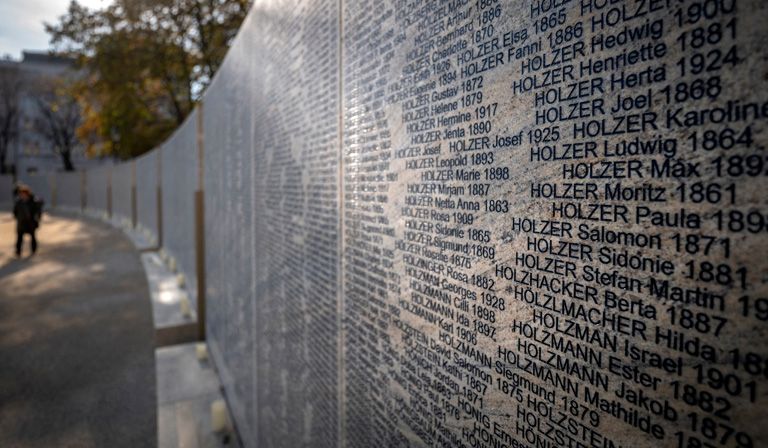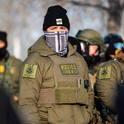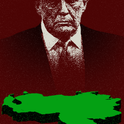“Antisemitism has played a shameful and shaming role in Austria’s history. But today, eight decades since the end of the Hitler regime, antisemitism in Austria has been decisively pushed into the background.”
Heinz Fischer, Austria’s president from 2004 to 2016, is optimistic about his country’s approach to antisemitism when we meet in Vienna this spring. “Politicians cannot permit themselves antisemitic remarks without risking consequences, including resignation,” he insists.
But is he right? Today, the Jewish community in Austria has shrunk to near invisibility, standing at around 10,000 members. Antisemitism has become both a political and a church taboo, as the authorities promote a wide range of measures to drive home the lessons of the Holocaust. Yet antisemitism has not disappeared. It is nowhere near prewar levels, but it simmers below the surface.
Many refugees who fled Austria before or during the Second World War still refuse to set foot there. But I, a Kindertransport survivor, have no compunction about visiting my native country and cannot recall being made to feel uncomfortable there. I have always wanted to understand why others felt differently. So I decided to ask a variety of Austria’s politicians and intellectuals just how significant antisemitism is in the country today.
Austria’s current president Alexander Van der Bellen, a highly respected former professor and a former leader of the Greens, is outspoken in his condemnation of antisemitism. He stresses that during most of the last four decades, the country has had governments committed to fighting antisemitism, paying restitution and seeking reconciliation with Holocaust survivors and their families.
We are meant to meet in person, but after he tests positive for coronavirus on the day of our interview, we end up exchanging emails. I ask him what he can do as elected head of state, and how much influence he has in the campaign against antisemitism. He is cautious in his reply: “My responsibility is to safeguard the constitution,” he says. After all, the country’s chancellor is head of the government; Van der Bellen cannot intervene with policy proposals. But where human rights or democratic norms are at risk, he tries to stretch the boundaries. “I can, through public statements, contribute to the debate. As a citizen as well as president it is incumbent on me to speak out against injustice, discrimination and degradation… I have always done that with conviction and will continue to do so; especially with respect to the campaign against antisemitism. National Socialism and its murderous ideology must never be allowed to recur. Never again!”
We are talking against the backdrop of political turmoil in Austria, where last year the far-right populist Freedom Party (FPÖ) overtook the centre-right Austrian People’s Party (ÖVP) and then the Social Democratic Party (SPÖ) to the lead in the polls. In recent elections in two of federal Austria’s regions—in Lower Austria and in Salzburg—the FPÖ scored so well that they have controversially become junior partners in the newly formed regional coalition administrations. In next year’s federal elections, the FPÖ could well be in a position to join a coalition government, possibly even claiming the chancellorship.
The party owes much of its appeal to its anti-immigration campaign, but alarm bells are also ringing because of the FPÖ’s antisemitic roots—its first leader was Anton Reinthaller, a former senior SS officer and member of the Nazi parliament—and the concern this raises that today it remains a home for antisemites.
I ask the president whether the current Austrian government—a coalition of the ÖVP and the Greens—has been doing enough to combat antisemitism. The answer is affirmative: this government and its predecessors “have taken a determined role to confront an inhumane ideology that continues to renew itself and capture human minds,” he says. “We are all duty-bound, again and again, to see this clearly and to react. The fight against antisemitism, and indeed against every form of human rights violation, must be fought on a daily basis.”
Heinz Fischer, Van der Bellen’s predecessor, tells me there must be caution against jumping to conclusions, arguing that support for the FPÖ should not be taken as proof of growing antisemitism. He stresses that the FPÖ is the beneficiary of dissatisfaction with the governing coalition, led by the ÖVP, and falling support for the SPÖ, which has been mired in leadership problems.
Alarm bells are ringing because of a concern that FPÖ provides a home for antisemites
The FPÖ, in this view, is not gaining support because of its antisemitic roots, but is mopping up the malcontents and owes much of its success to public concern about the number of asylum seekers, as well as over inflation and stretched public services. Fischer also cites general fears and uncertainties about the future as other factors that are driving people to vote for the FPÖ.
Yet he admits that concerns about the place of antisemitism in the party are not without foundation: “All that having been said,” Fischer adds, “I don’t doubt that the ranks of the FPÖ still contain some antisemites.” Austrians designate such people as Kellernazis (cellar Nazis). “The party tries to hide this and to deny this. But they do that precisely because they know that antisemitic actions or declarations could harm them,” he says.
As former president, Fischer is free to comment. In contrast, as the ruling head of state, Van der Bellen must stay above the political fray. However, in our emails he also expresses a rare hint of concern over some of the FPÖ’s positions. Answering one of my questions, the president comes close to setting off an explosion in this political minefield. Is it a reference to the FPÖ when he stresses that “anti-democratic, authoritarian tendencies must be repressed with speed and determination”?
Certainly, he leaves no one in any doubt that he takes the strongest stand against antisemitism. The slogan “Never again” (Nie wieder) makes “demands of us all,” the president tells me. “We must never again create the situation we had in the 1920s and 1930s that led us to the biggest crimes ever committed by mankind.”
He steers clear of assessing the degree of antisemitism in Austria today, but a disturbing study commissioned by the Austrian parliament was published only this April. It demonstrates that mainstream political leadership has only made limited headway in stifling antisemitism and promoting public understanding and acceptance of Austria’s conflicted record during the Holocaust.
The study shows that many of the old antisemitic shibboleths survive, with a third of those questioned believing that Jews “dominate international business” and exert growing “power and influence in politics and the media”. Between 2020 and 2022, the percentage of respondents who said Jewish people had “too much influence” rose from 11 to 19 per cent.
It notes that there is significant antisemitism among Austria’s Turkish and Arab immigrants, who have historic concepts about Jews and Israel. Negative attitudes to Israel play an important part in stimulating Austria’s antisemitism. The study alarmingly points out that 31 per cent of people questioned believed that Israel’s treatment of Palestinians was no different from Nazi Germany’s treatment of Jews during the Second World War (the figure was 57 per cent among Turkish- and Arabic-speaking respondents).
New elements are also present, with around a third of the sample taken believing that Jewish people today “take advantage” of their victimhood during the Holocaust, while a fifth thought that Jews were at least “partly responsible” for their historical persecution. The bleak picture also shows less than half the respondents were aware of the enormity of the Holocaust or knew that six million Jews had been murdered. Significantly, the report avoids pointing fingers at any of Austria’s political parties.
Stressing his concern over the findings of this study, the president of the lower chamber of the Austrian parliament, Wolfgang Sobotka, declared that this is “not a phenomenon of the political fringe groups. It comes from the middle of society.” Or, as the saying in Vienna goes: “Antisemitism and racism are like Wiener Schnitzel.” They are part of Austria’s cultural heritage.
Jews have been in Austria since the 12th century but were only granted full citizenship rights in 1867. Antisemitism had traction throughout modern times.
It was a characteristic of the Habsburg era, during which the emperors, with the Catholic Church as a ready partner, led the way to ostracise Jews. Later, antisemitism largely shifted from the Church and the country’s ruling elites to lower-income groups. Then, after political parties first emerged in the late 19th century, it also took root as a political tool.
Further provoked by the heavy influx of impoverished eastern European orthodox Jews, antisemitism then gained in strength among the racist forces that campaigned for German purity, with Austria as part of the greater German Reich. By 1938, when Austrians jubilantly fell into Hitler’s embrace, promotion of antisemitism had become central to political life. The terrible message was unequivocal: Austria must act to rid itself of its 185,000 Jews.
More than 64,000 Austrian Jews perished in the Holocaust. The fortunate were able to emigrate, but only after all their possessions had been seized. Several thousand Jewish children were saved and put onto the Kindertransport to Britain.
At the end of the war, the National Socialist German Workers’ Party (NSDAP)—the Nazi party—still had close to 700,000 members in Austria. One of the first actions of the country’s Second Republic was to dissolve it; members were deprived of their voting rights until 1949. Then, a remnant of the former Nazi party formed a new one—the Federation of Independents, or the VdU. The founders hoped it could act as a counterpoint to the two big anti-fascist parties, the SPÖ and the ÖVP. But with postwar Austria driving towards democracy, the VdU, with pro-Nazi hardliners prominent within its ranks, found it politically impossible to make significant headway.
By the time the Austrian state treaty was signed in 1955, re-establishing an independent and democratic Austria, the VdU, anxious to purge itself of its Nazi association, had transformed itself into the FPÖ. The new FPÖ carefully sidestepped any mention of antisemitism in its party ideology—to have included it would have been illegal. But in my conversation with Fischer, the former president tells me that the party vocabulary still carried obvious antisemitic tones, and that many of its members denied the existence of the Austrian nation and clung to the concept of the “greater Germany”. “The FPÖ stood between right and far right,” he says.
Since those early times the FPÖ has had a chequered history. Bruno Kreisky, Austria’s social democrat chancellor from 1970 to 1983, formed a controversial political friendship with Friedrich Peter, an FPÖ leader who was a member of the Nazi SS stormtroopers before later insisting that he had come to oppose any form of antisemitism. Fischer seems to find this change of heart credible. Peter “was part of a delegation that visited the former concentration camp, Theresienstadt, and I observed how deeply he was affected,” Fischer says. “It gave me much food for thought.”
One of Peter’s successors as FPÖ leader, Norbert Steger, tried to get rid of the Kellernazis but was ousted in 1986 by the largely unreconstructed populist Jörg Haider. Under Haider’s leadership, FPÖ membership grew impressively, and after elections in 2000 chancellor Wolfgang Schüssel, leader of the conservative ÖVP party, brought Haider into his coalition. “Haider was too clever to adopt an antisemitic role,” Fischer says. “He knew what the consequences of that would have been.” Still, the European Union was not deceived, imposing sanctions against Austria for Haider’s invitation to government. The sanctions have long gone, but the antisemitism evident in the FPÖ’s past continues to cast a long shadow over Austria’s political life and its Jewish population.
Unlike Germany, Austria does not yet have a Holocaust museum. Karoline Edtstadler, the ÖVP’s minister for the EU and constitutional affairs, tells me there were plans to create something similar; other officials insist that Austria’s notorious Mauthausen concentration camp has been turned into a quasi-Holocaust museum, and that is enough. One of my Austrian acquaintances sharply disagrees, claiming that Mauthausen has been sanitised, with some of its cruellest aspects removed. Visitors can no longer see the true horrors of the Holocaust there.
Since November 2021, Austria has been able to pride itself on its dramatic wall of remembrance, inscribed with each of the names—my grandmother included—of the 64,000 Austrian victims of the Holocaust. At once profoundly moving and also deeply challenging, the large semi-circular stone Shoah Wall of Names stands in a beautifully landscaped setting not far from Vienna’s inner city. It was the initiative of a Jewish survivor, Kurt Yakov Tutter, who campaigned for more than two decades to overcome the reluctance of the Austrian government to authorise and build it. On a bitterly cold day, Austria’s great and good turned out in force for the unveiling ceremony, congratulating themselves for honouring Austria’s Holocaust victims.
The country’s Jewish leaders and the president of the World Jewish Congress, Ronald Lauder, have praised the initiative and singled out Austria as a leading light in the fight against antisemitism. Austrians are being encouraged to visit the wall, and schoolchildren are taken there regularly as part of their Holocaust education—the subject is well placed in the school curriculum. During the last few years, the chancellery has also commissioned video interviews with as many survivors as are still alive, which will be preserved and accessible (as videos and in massive written volumes) in the country’s official archives.
Vienna has a flourishing Jewish Museum, which was established in 1988 and is strongly supported by the city authorities. Its new director, Barbara Staudinger, a historian who is not Jewish, cuts a controversial figure. Her first big exhibition, “A Hundred Misunderstandings About and Among Jews”, tackled Jewish stereotyping. Leading members of Austria’s Jewish community were outraged, claiming it trivialised Jewish experience and suffering. Staudinger has no misgivings, arguing that Jews as well as non-Jews must be challenged if antisemitism is ever to be overcome. “We have to explain the origins of antisemitism—its history—and this exhibition is an attempt to signpost where to go.”
In a second exhibition, Staudinger has addressed another difficult topic: guilt, both individual and collective, and how it relates to antisemitism. Here, too, she is in search of origins, of evolving moral concepts and historic trends. The first painting to confront the visitor is of Adam and Eve—symbolic as the triggers for all sin and guilt. Little did the pair know they would have a role to play in the unending tragedy of antisemitism.















